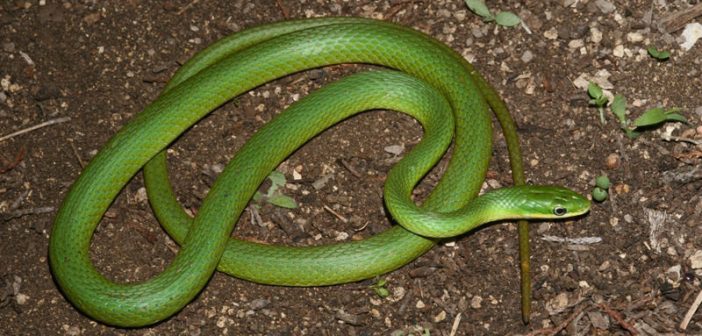A personal wildlife story, by Tara Allison
Do you have a wildlife story to share?
I was taking an afternoon walk on a narrow asphalt path with my two large dogs when I spotted a Rough Green Snake1 (Coluber constrictor) ahead of us. Snakes aren’t aggressive and usually move quickly out of sight, so that’s what I expected. However, this one stayed in place. As we got closer, it began coiling and taking short lunges at us. Something wasn’t right with it.
As I studied it, I saw a problem, a significant one: A small piece of plastic netting was encircling its body midway down. It was the kind of red-colored netting you often see as packaging for produce, such as whole garlic and lemons, at the grocery store. Only a tiny bit of the net remained—a plastic strand stretched so thin it was now no thicker than a thread. It was clear the snake had been wearing it for a while, since when it was younger and smaller. The net was now constricting and embedding into its body. This little snake couldn’t move very well and was having a very rough time (pun intended) of it.
I had no way of helping him there, if at all. Knowing he wasn’t venomous, I swiftly grabbed him by the tail, held him away from my body, and off we went: a middle-aged woman, two large dogs, and a 30-inch-long snake whipping back and forth below her outstretched arm.
Soon, we attracted the attention of a man peering out his backdoor (and probably several other people who were hiding in fear of the crazy lady.) As I approached him to ask for help, I saw he was an older gent and somewhat frail. Still, he stepped out of his house, apparently willing to help. I suspect that was mostly because he couldn’t see all that well—as we drew closer, his eyes got huge!
We introduced ourselves. I explained the situation to Mr. Glover,2; he was willing to help. “What do you need?” he asked, his eyes glued to the snake. I replied, “Gloves and tiny scissors, please.” He brought me a rubbery gardening glove and two enormous carving knives. I suggested something smaller, much smaller, like cuticle scissors or even nail clippers might do. So he then brought out grass clippers and large tin snips. To my astonishment, he asked on which side of the netting he should cut the snake in two!
“Umm, maybe I should do the cutting,” I said, “it’s just for cutting the net, and something smaller still would be better.” Cheerful and agreeable, Mr. Glover shuffled back inside and brought out two pairs of scissors—large and very, very large (think of grass shears). Defeated, I took the smaller of the two and oh-so-carefully tried to clip the strand without cutting the snake. I did it! With relief, I carefully peeled off the rest of the net. Whew!
I wanted to take a photo of it and thought about asking Mr. Glover if he had a camera, but I was suspicious it would be a large wooden one mounted on a tripod, complete with a black hood! He watched my dogs for me while I carried the exhausted snake back to where I found it. When I put him down, he quickly slithered away into the tall grasses, which I took as a good sign.
I wish I could have transported him to Great Plains Nature Center here in Wichita, where he would have been assessed and cared for. But I knew I couldn’t handle a rowdy snake and my two large, boisterous dogs on the long walk back to my house. Too late, I realized I might have been able to borrow a pillowcase or bag to put the snake in to carry back home.
I trudged back to my dogs and Mr. Glover. He and I both now had a good story to tell. Oh, and after that, my dogs and I came across a Seven-spotted Lady Beetle (Coccinella septempunctata) sitting on the path. I put my hand down, and it immediately climbed aboard and rode along with me for a while, making it my best walk ever!
There’s an important moral to this story—a reminder for all of us to keep our trash in our trash cans. People throw away two hundred million tons of trash every year in the U.S. alone. Some of it escapes when wildlife or wind draws it from unsecured trash receptacles. Some of it is carelessly flung into the environment by people camping or picnicking. Discarded fishing lines trap waterfowl and other animals. Broken glass cuts the feet of animals. Unbroken bottles and jars are hazards to lizards or other animals who crawl into them seeking leftovers but can’t squeeze back out or get their heads caught in the opening. Plastic six-pack holders are notorious for trapping wildlife. The examples can go on and on.
1 Top photo is not the snake in the story
2 Not his real name





